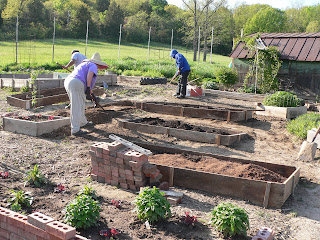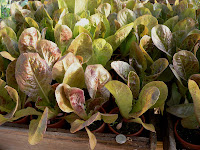 Chives, a member of the onion family, are continuous givers of pleasure and food. They are a delight to the palette as well as to the eye. I continually try to influence the visitors to my garden to try a lot not just a few groups.
Chives, a member of the onion family, are continuous givers of pleasure and food. They are a delight to the palette as well as to the eye. I continually try to influence the visitors to my garden to try a lot not just a few groups.
Chives take almost no care. They crowd out weeds. The tight knit clumps discourage infiltration. I say discourage because a grass seed or other weed seed can sneak in. As you are taking a walk-about in your garden you need to be vigilant, pull them when they are tiny before they establish a root mass which becomes inextricably entangled in the chive's roots. Chives are not very picky about their soil conditions. I have planted them in everything from pure clay to Florida's sandy soil (?). 

The ones you see here are planted in composted manure. It is several kinds of mixed manures with their bedding. I didn't know if it would work. The area is a waste land area along side the curve in the road. Even though our drive forms the triangle shaped area , and it runs across the front of our property, it belongs to the county. They never take care of it and it was overgrown with weeds and lots of poison ivy.
Many years ago we tried unsuccessfully to improve the area. We became tired of replanting and grubbing out the weeds. We had to continually replant because people would stop and dig up our plants. The gate cannot be seen from the house or garden. In the past two years a subdivision has been built on the farm land across from us. We figured we'd try again. thinking we'd have better luck with the increase of traffic stopping the thefts.
 This is the view after we cleaned the area and applied an eight inch layer of the manure compost. I had not given any thought as to what would be appropriate to plant there. The manure is still very hot. It is only composted for two weeks. We figured if nothing would grow, then the weeds wouldn't either. So problem solved, we wouldn't need to plant or mow or weed eat.
This is the view after we cleaned the area and applied an eight inch layer of the manure compost. I had not given any thought as to what would be appropriate to plant there. The manure is still very hot. It is only composted for two weeks. We figured if nothing would grow, then the weeds wouldn't either. So problem solved, we wouldn't need to plant or mow or weed eat.
This was in April when the rains were coming almost everyday. I was hoping the "mulch" would be leached of its excess nitrogen and be a safe environment for plants. The night after spreading the "mulch" we had a thunder-buster of a rain. It took the fluff out of the bed making it about 4 inches high. It rained off and on for the next two weeks. We had time to plan what to plant. Our choice was made easy and fast. We have been doing lots of renovating in the garden adding new raised beds (new in the sense that they are in a new location. Most of our beds are made of recycled lumber.) I needed to move a nursery row of lambs ears and a long row of chives that were where the new beds needed to be. I couldn't throw such nice plants in the compost pile!
"Light bulb", If you are considering digging them up and composting them, why not give them a chance down at the gate in the manure. thinking that if they didn't grow I wouldn't be out anything because I was going to throw them away. They didn't just grow, they thrived. By this picture you can tell these were not small plants. The only problem we noted from the first was the stuff was to dry and porous. the water went right through. for almost a month I was carrying water to the gate in my "little red rooster" (that is what I call our motorized golf cart type "truck" that cannot be used on roadways.)
 This is the area in June. As you can see things seem to be thriving. I have extended the area with more compost to the other side of the fence. The only thing I have planted there is more lambs ear. The shade is too dense. The lambs ear doesn't seem to mind. I have been trying hostas. The deer are leaving them alone (too much traffic).
This is the area in June. As you can see things seem to be thriving. I have extended the area with more compost to the other side of the fence. The only thing I have planted there is more lambs ear. The shade is too dense. The lambs ear doesn't seem to mind. I have been trying hostas. The deer are leaving them alone (too much traffic).
The only problem we are having is the porousness of the medium. As it breaks down and the roots dig in deeper we should have to water less.
I have since planted mums and geraniums. They seem to be adjusting well. They receive only 1/3 of a day sun in the morning. I also planted 2 lilac bushes. The one is 3/4 day sun, in gravely soil under the compost. It was doing poorly but it has since come up from the roots and looks wonderful. I hope it puts on a growth spurt with the fall rains. The other one only gets about 1/2 day sun and it doesn't seem to be growing. It is in better dirt, but the tree is probably sapping some of its nutrients, and probably the water.
Back to the chives. They were just trimmed back for the second time. They had that late summer droop, and the long hot summer had dimmed their normal bright green color. The cooler weather in September should perk them right up.
Please consider useing chives for more than a gastronomic delight.










